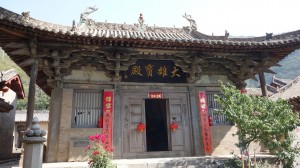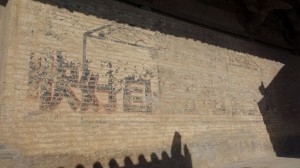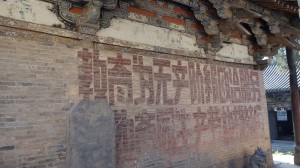by Jeffrey Schwab

The road is black as soot. The air remains dense, with a fog so thick that I can grab it into a ball and mold a Fogman. After ten hours of driving from Beijing on October Holiday, I begin to wonder why I’ve come this far. Of course I know the answer…relics from the past. Somewhere in the fog, the layers of history await to be discovered on this autumn drive through the shrouded mists.
 Shanxi isn’t actually that far from Beijing, and yet it’s a completely different world. With its economy relying on heavy industry and coal, Shanxi is also the birthplace of China’s Golden Era. Its capital of Taiyuan lays claim to being the origin of the dynasty that launched Han Chinese culture into its most prosperous era, producing the only female “emperor” of China, the dreaded and respected Wu Zetian. In addition to being home to famous historical figures from the Golden Era, 70% of China’s remaining pre-Yuan dynasty timber structure architecture survives in Shanxi.
Shanxi isn’t actually that far from Beijing, and yet it’s a completely different world. With its economy relying on heavy industry and coal, Shanxi is also the birthplace of China’s Golden Era. Its capital of Taiyuan lays claim to being the origin of the dynasty that launched Han Chinese culture into its most prosperous era, producing the only female “emperor” of China, the dreaded and respected Wu Zetian. In addition to being home to famous historical figures from the Golden Era, 70% of China’s remaining pre-Yuan dynasty timber structure architecture survives in Shanxi.
It is for these structures, and the layers of stories behind them that I make the drive through the fog.
One of the most impressive sites that I visit during the trip has to be the Longmen Temple 龙门寺。Hidden away in the muscular mountains outside of the city of Changzhi 长治 in Pingshun County 平顺, the buildings within the Longmen Temple complex lies amidst the Taihang Mountain range just near the border of Shanxi and Hebei. Rumbling over rocks and rubble in my rented car I follow the signs to the temple and drive up a somewhat precarious pass until I reach the top. There is a beautiful walking path decorated with yellow flowers and bumblebees waiting for those who prefer to walk. After I park my car, I walk down the path a few hundred meters to enjoy the quiet sunshine that has magically emerged.
 The temple itself is quite impressive, laying claim to two structures dating back to China’s Song and 5 Dynasties and 10 Kingdoms period. It’s the main hall from the Song Dynasty that strikes me as the most dramatic. Although the structure itself dates back to the Song, it’s the layers of history that lie upon this building that truly impact me. On the left side of the building lie the scars of the Cultural Revolution, gigantic red letters that somewhat translate to “Education serves proletarian politics.” On the right side of the building, another scar, this one from years earlier during the Great Leap Forward:
The temple itself is quite impressive, laying claim to two structures dating back to China’s Song and 5 Dynasties and 10 Kingdoms period. It’s the main hall from the Song Dynasty that strikes me as the most dramatic. Although the structure itself dates back to the Song, it’s the layers of history that lie upon this building that truly impact me. On the left side of the building lie the scars of the Cultural Revolution, gigantic red letters that somewhat translate to “Education serves proletarian politics.” On the right side of the building, another scar, this one from years earlier during the Great Leap Forward:
“Go all out, aim high, and achieve greater, faster, better and more economical results in building socialism.”
 After the sheer beauty of the structure, these two scars are the most eye-catching layers that I notice. Still, when I look deeper into the building, I find more layers. The colors on the paintings below the hanging bracket sets are from the Qing Dynasty. When I step into the structure I notice the subtle and gentle Buddhist murals on the wall. The man working at the temple tells me the murals are from the Ming Dynasty.
After the sheer beauty of the structure, these two scars are the most eye-catching layers that I notice. Still, when I look deeper into the building, I find more layers. The colors on the paintings below the hanging bracket sets are from the Qing Dynasty. When I step into the structure I notice the subtle and gentle Buddhist murals on the wall. The man working at the temple tells me the murals are from the Ming Dynasty.
Song, Ming, Qing, Great Leap Forward, Cultural Revolution.
Now. It all leads to the present moment, and I am astounded at what this building has survived. The layers of the building tell its story, hiding away in the mountains, existing as a temple for hundreds of years, and then a schoolhouse for a short period during the Cultural Revolution. Now it’s a site to be visited and understood.
A bumblebee hovers around my head and flies off to some flower. I hear the sound of birds chirping in the eaves of the temple, hiding in the crevasses. They add to the layers, and so do I.











